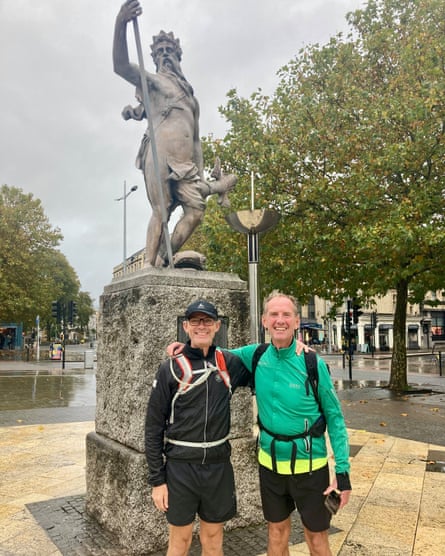
From our knees down it’s almost impossible to tell where our legs end and our trainers begin. A thick crust of oozing river mud is glued to our shins and smothers our shoes. Our skin fizzes and tingles from the spiteful attention of hundreds of nettles enjoying their last hurrah as winter approaches. But if you panned up from the battlefield of those middle-aged legs to the sweat-streaked faces above, you’d find something you might not expect: laughter, excitement and a deranged look about the eyes.
My friend Alan and I are a few hours into a self-supported, three-day adventure to run the length of the historic Kennet & Avon Canal, the most southerly (and possibly most beautiful) broadbeam waterway that traverses the width of England, allowing narrowboats to travel coast to coast, from Bristol to London. It was a route that was intended to revolutionise 18th-century trade. Rather than having to deal with the rocky hazards and treacherous seas of the south coast and the Channel, not to mention pirates and the unwanted attention of the French navy, merchants would simply be able to drift along the canal, arriving safely at their destination.
The canal was a monumental feat of civil construction. The first 18-mile section, from Newbury to Reading, became navigable in 1723, just over 300 years ago, while the final section was finished 90 years later, in 1810. The ambitious engineer who oversaw much of the project was the masterful John Rennie – he was to canals what Isambard Kingdom Brunel was to railways. The entire venture cost £1m – a huge sum at the time, though Rennie himself was paid only a modest £360 for his efforts. By the time the canal was finished, travelling all the way from Bristol’s Floating Harbour to the most easterly lock on Reading’s River Kennet where it flows into the Thames, the waterway was 96 miles long, comprising 107 locks (now down to 105), 236 bridges, two steam-driven pumping stations, one mile-long tunnel and goodness knows how many pubs.
Despite its hugely impressive length, the Kennet & Avon was never prosperous and fell into disuse – thanks mostly to the opening of the Great Western Railway, which followed a parallel route, so that goods that might have been loaded on to barges found themselves on carriages, and the canal began its long and inevitable decline, until the last craft finally navigated it in 1952.
But all was not lost. In the latter half of the 20th century, an army of volunteers and enthusiasts began renovating it and in August 1990 it was reopened by Queen Elizabeth. It’s a wonderful irony that the canal, built in the name of commerce, trade and enterprise, is now a spectacular wildlife preserve. It is home to many species of birds and numerous animals and fish, and it’s a place of rest and relaxation for walkers, kayakers, cyclists – and, of course, a few runners, like Alan and me.
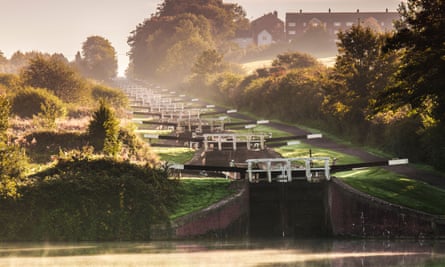
The great advantage of canal jogging is that it’s flat – hills are anathema to middle-aged plodders. It’s also quite hard to get lost, there are feeding stations (pubs) at regular distances and, if you start in the west, you might be lucky and have the afternoon sun and the prevailing wind at your back, gently nudging you along.
That was the plan, anyway. What we hadn’t factored in was that during November the sun doesn’t hang around for long, the off-season pubs are mostly closed, the afternoon darkness falls faster than a dropped pint of Guinness and, oh yes, there was a lot of mud…
We started early on a Saturday morning in Bristol, after a hearty breakfast overlooking the city’s fascinating Floating Harbour. The sky was blue, but weeks of heavy rain meant we often had to wade up to our knees in sludgy water in many places along the towpath. It was slow going. After a morning of slithering and sliding, we approached Bath, the river water so high that it was lapping the foundations of many of the city’s elegant stone bridges. Cloaked in mud, we lurched into a pretty Georgian square for lunch; tourists gawked at us as if we were prehistoric men dug up from an ancient bog. We loaded up on pasta and lemonade before heading back to the towpath and eastwards out of the Roman city.
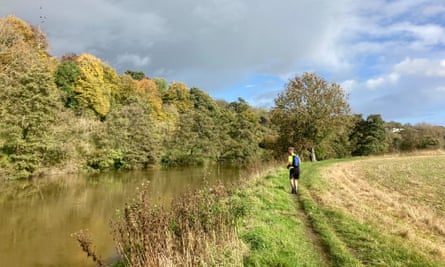
After a few more muddy miles, we stopped at one of the jewels of this great canal, the outrageously decorous Dundas aqueduct – a curving triple-arched construction designed by John Rennie and completed in 1805 that lets the canal flow high over the surging River Avon below.
We plodded on and on, though Bradford-upon-Avon, with its medieval barns and bridges and then, finally, in the pitch dark, we arrived at that temple of modern convenience – Melksham’s Travelodge. We looked like extras from All Quiet on the Western Front as we fell into our room. I had a shower, but Alan felt a bath was the only answer to the filth. When he got out of the tub it looked like a swamp – there was so much mud left behind that the plughole blocked. We confessed all to the jolly receptionist, who just laughed and said, “Oh, don’t worry at all, I’ve seen a lot worse than that!”
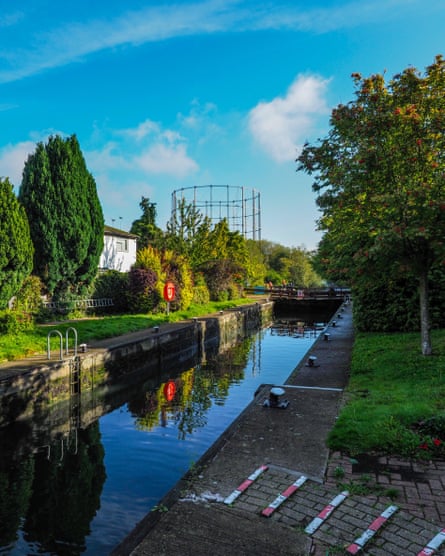
The next morning, stiff-legged and aching, we continued, ticking off the bridges and locks, towards the undisputed highlight of the canal – Caen Hill. Pronounced “cane”, it is the steepest flight of locks in the world – a total of 29 locks with a rise of 150m. It was the last part of the navigation to be completed. If you are lucky, and the lock gates are favourably in your direction, it’ll take you between three and five hours to ascend the flight on a narrowboat– you literally sail uphill.
The speed limit for boats on the canal is 3mph and at times I don’t think we were running much faster than that. But as we left our busy family lives behind, our racing minds slowed to match the steady cadence of our feet and it felt like exactly the right pace. Our random thoughts and happy inane chatter unfurled with every step as the lazy ribbon of the canal unspooled ahead of us. Keep moving and you’ll eventually discover a wonderful inner stillness.
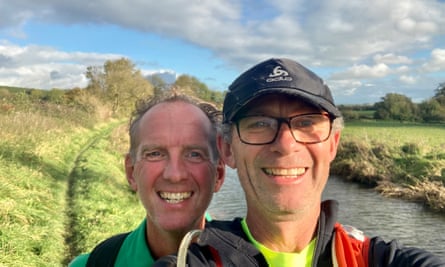
We spent the second night in Devizes, filling ourselves with food and fuel – onion rings and lasagne, four pints, why not? Two very muddy runners in the dining room of the much-loved Bear pub didn’t phase the locals at all.
The third day, and the last 30 miles of the canal towpath, was a slog. Our feet had swollen and blistered with the constant muddy wet – several toe nails were hanging by a thread. The names of the passing narrowboats seemed to sum up our situation: in the morning we saw one called “Isn’t This Pleasant” and that evening we saw another called “Absence of Reason”.
At last we hit the post-industrial hinterland of Reading. As we staggered towards the end, where the Kennet joins the Thames and boats can continue downriver to London, we found our route was suddenly blocked. The final 200m-stretch of the towpath was closed for work on a retaining wall. We couldn’t believe it! All this way and we aren’t going to actually get to the finish. We didn’t know whether to laugh or cry. We did a bit of both. In many ways it was perfect – after all, no one wants a great adventure to end.
For more information on visiting the Kennet & Avon Canal, go to canalrivertrust.org.uk



